By now, scientists have made it as clear as they possibly can that climate change is real and greenhouse gas emissions are to blame. But what is perhaps less well known is the natural role the Arctic plays in both accelerating climate change and spreading its often disastrous consequences around the world.
Recent research by the University of Leeds suggesting that the Arctic is melting much faster than expected. And scientists have even predicted that it could be ice-free in summer by the late 2030s.
As more and more carbon dioxide is pumped into the atmosphere, it warms the planet. And nowhere are the effects more dramatic than in the Arctic. The Arctic is warming faster than any other region on Earth and it causing the region’s ecology to undergo a rapid transformation.
Until now there has been limited information available on the response of Arctic wetlands to climate change and rising global temperatures. Now, scientists have reconstructed past moisture conditions and vegetation histories to determine how three main types of Canadian High Arctic wetlands have responded to warming temperatures over the last century.
They examined past ecological changes in the region that allows precise predictions of how future changes, such as longer growing seasons and increased water from the ground-ice thaw, could affect the wetlands and found that under 21st century warming conditions and with adequate moisture, certain Arctic wetlands may change into peatlands, making new natural carbon storage systems and somewhat moderating carbon losses from degrading peatlands in southern regions.
Study lead author Thomas Sim, a Ph.D. researcher in the School of Geography at Leeds, said: “High Arctic wetlands are important ecosystems and globally-important carbon stores. However, there are no long-term monitoring data for many of the remote regions of the Arctic – making it hard to determine their responses to recent climate warming.”
“Reconstructing the ecological history of these wetlands using proxy evidence can help us understand past ecological shifts on a timescale of decades and centuries.”
Study co-author Dr. Paul Morris, from the University’s research center water at Leeds, said: “Our findings show that these harsh and relatively unexplored ecosystems are responding to recent climate warming and undergoing ecosystem shifts.”
“While some of these wetlands could transition into productive peatlands with future warming, the long term effects of climate change is likely to vary depending on the type of wetland.”
“Although new productive peatlands may form in places such as the High Arctic, degrading peatlands in other areas is a major global concern. Every effort should be made to preserve peatlands across the globe – they are an incredibly important component of the global carbon cycle.”
Scientists then examined ecological responses to 20th-century warming in the three types of High Arctic wetland: polygon mire, coastal fen, and valley fen. Plant macrofossils and testate amoeba – tiny, single-celled organisms that live in wetlands – in combination with radiocarbon dating, were used as proxies for historic changes in vegetation and moisture levels.
The study found that all three wetland types – with the exception of certain sections of the polygon mire – have experienced ecosystem shifts that coincided with an increase in growing degree days, a unit scientists use to quantify growing season length and warmth.
The coastal fen site experienced an increase in shrub cover related to warming, while sections of the polygon mire increased in moss diversity.
The study also found that environmental factors other than warming temperatures may be contributing to vegetation changes. The research suggests that grazing Arctic geese may have contributed to the recent shift of from shrubs to mosses in the coastal fen site.
Arctic geese populations have risen significantly and food competition at their summer nesting sites may be causing them to seek new grazing sites further north as they warm.
Study co-author Dr. Jennifer Galloway, Associate Professor at Aarhus Institute of Advanced Studies in Denmark and Geological Survey of Canada, said: “Our study highlights the complex ways in which climate change is affecting ecosystems and suggests that effects of climate warming will vary depending on wetland type.”
“While we can clearly see that climate change is altering ecology across the Arctic wetlands, whether that will result in a transition to productive peatlands will be strongly influenced by the complex dynamics that govern the wetlands.”
The study is published today in Geophysical Research Letters.

